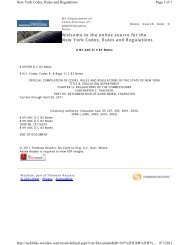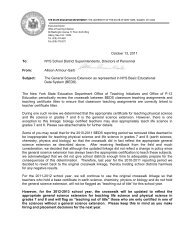ESL Learning Standards - Higher Ed - New York State Education ...
ESL Learning Standards - Higher Ed - New York State Education ...
ESL Learning Standards - Higher Ed - New York State Education ...
Create successful ePaper yourself
Turn your PDF publications into a flip-book with our unique Google optimized e-Paper software.
Students learning English as a second language will use English to interact with others in social and<br />
classroom situations. They will develop and use skills and strategies appropriate to their level of<br />
English proficiency to communicate effectively with regard to audience, purpose, and setting.<br />
Performance Indicators: See page 24<br />
Advanced<br />
Teacher provides students with scenarios for role-playing<br />
difficult social situations. Students brainstorm a list of possible<br />
attitudes and/or behaviors. They secretly choose an<br />
attitude/behavior for the role-play and conduct the roleplay.<br />
Class discusses the consequences of the observed<br />
behaviors. Partners in role-play reflect together on what<br />
they learned about appropriate communication skills and<br />
include these reflections in their individual learning journals.<br />
Performance indicators: 4, 6, 7, 8, 9, 11, 12<br />
English Proficiency Level<br />
Transitional<br />
Students brainstorm a variety of behaviors that might arise<br />
in a class discussion (e.g., tapping a pencil, talking too<br />
much, interrupting, raising hands, disagreeing). They read a<br />
highly controversial article and conduct a class discussion<br />
while assuming one of the listed roles. Roles may shift in<br />
five-minute intervals. Students reflect in writing on what<br />
they learned about appropriate communication skills.<br />
Performance indicators: 4, 6, 7, 8, 9, 11, 12<br />
After a class discussion about school experiences (e.g., eating<br />
in the cafeteria, changing classes, using metal detectors),<br />
students send a friendly note describing activities in<br />
their school to an Internet pen pal through Epals.com, or to<br />
a friend who lives in another community.<br />
Performance indicators: 1, 2, 5, 9, 10<br />
Students complete Intermediate task. In small groups, they<br />
write descriptions of artifacts and student work posted on<br />
bulletin board and display these descriptions along with the<br />
artifacts.<br />
Performance indicators: 1, 3, 4, 7, 8, 9, 10<br />
Using a computer program (e.g., word processing, graphics,<br />
spreadsheet), students design and write a brochure for<br />
prospective students and their families describing specific<br />
programs and activities offered by their school.<br />
Performance indicators: 1, 2, 9<br />
Students create a computer slide show that introduces the<br />
school and all the <strong>ESL</strong> students to families. They prepare a<br />
display of student and staff pictures, including student bios<br />
and staff roles.<br />
Performance indicators: 1, 3, 4, 6, 7, 8, 9, 10<br />
<strong>ESL</strong><br />
4<br />
Interm<br />
Students complete Intermediate task. They collect information<br />
on a wide range of activities to meet the interests of a<br />
broad audience. Then they compile their information in a<br />
notebook, organized by category and type of activity.<br />
Performance indicators: 1, 2, 3, 6, 8, 9, 11, 12<br />
Students complete Advanced task. They host a “job fair” for<br />
interested students. <strong>ESL</strong> students host information booths<br />
organized by category and activity, answer questions, make<br />
suggestions, and pass out information on specific activities<br />
(duplicated from notebook).<br />
Performance indicators: 1, 2, 3, 4, 8, 9, 10, 11, 12<br />
Continued on next page<br />
CLASSROOM<br />
TASKS<br />
Sample Classroom Tasks 81
















